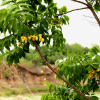Neem trees are hardy and drought-resistant. They thrive in tropical and subtropical regions with well-drained soil.
The neem tree is a valuable and versatile plant with many uses, from medicine to agriculture and beyond. Its cultural and environmental significance makes it a cherished tree in many parts of the world.
- Size: Neem trees can grow to be quite large, reaching a height of 15-18 meters.
- Water: Neem trees do not require a lot of water, they actual thrive in dry soil. Water but do not over-water.
- Fertilising: Neem Trees require a high nitrogen fertiliser. Use our slow-release nitrogen-rich all plant fertiliser Apply 1 teaspoon every 4-5 months
- Leaves: Neem leaves are pinnate and resemble those of a compound leaf. They are green and have a distinct serrated edge.
- Flowers: Neem trees produce small, white, fragrant flowers that are typically arranged in clusters.
- Fruits: The neem tree bears olive-sized fruits that are yellow-green when ripe. These fruits contain a single seed.
- Bark: The bark of the neem tree is dark brown and deeply furrowed.
Uses:
- Medicinal: Neem has been used in traditional medicine for centuries. Various parts of the tree, such as leaves, bark, seeds, and oil, are used for their antiviral, antibacterial, antifungal, and anti-inflammatory properties.
- Agricultural: Neem extracts and neem oil are used in agriculture as natural insecticides, fungicides, and soil conditioners. They effectively control pests while being relatively safe for beneficial insects and the environment.
- Personal Care: Neem oil is also used in products such as soaps, shampoos, and lotions due to its skin-nourishing and antimicrobial properties.
- Cosmetics: Neem-based cosmetics are used in various skincare products for their potential to address issues like acne and skin irritations.
- Traditional Practices: Neem has cultural and religious significance in many parts of India and other regions where it grows. It’s often called the “village pharmacy” due to its multifunctional benefits.
Cultivation:
- Neem trees are hardy and drought-resistant, making them suitable for arid and semi-arid regions.
- They prefer well-draining soil and semi sunshade but can tolerate a range of soil types.
Environmental Benefits:
- Neem trees offer ecological advantages as they help combat soil erosion and desertification.
- They provide shade and contribute to biodiversity by attracting birds and insects.
Note:
- While neem has numerous benefits, it’s essential to use it responsibly. Like any natural product, there might be potential side effects or interactions. Consulting with a knowledgeable source before using neem for medicinal purposes is recommended.








